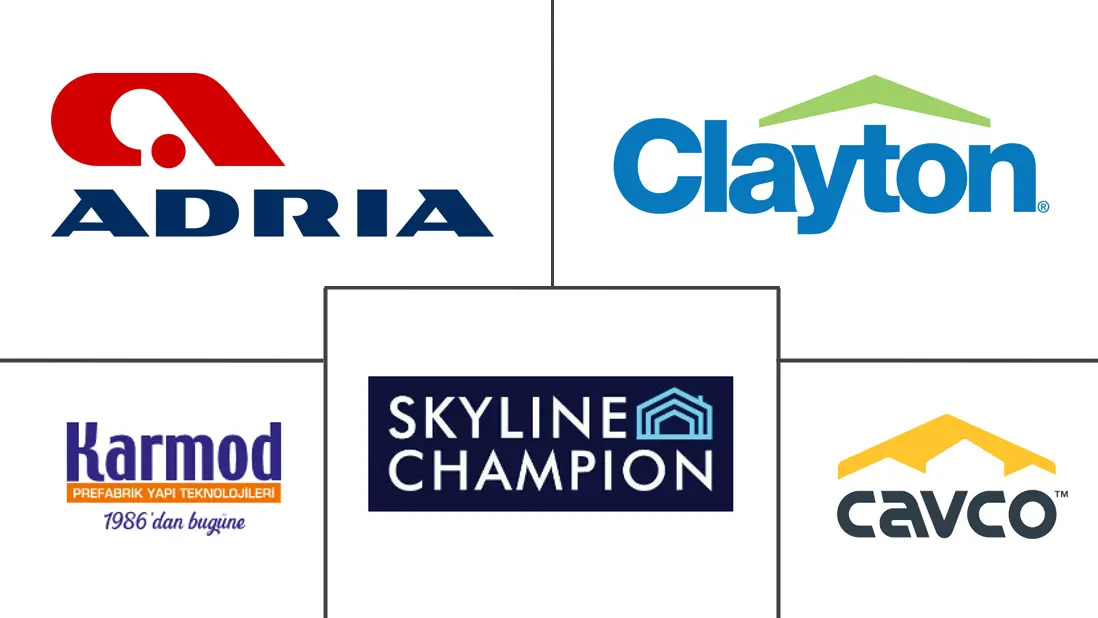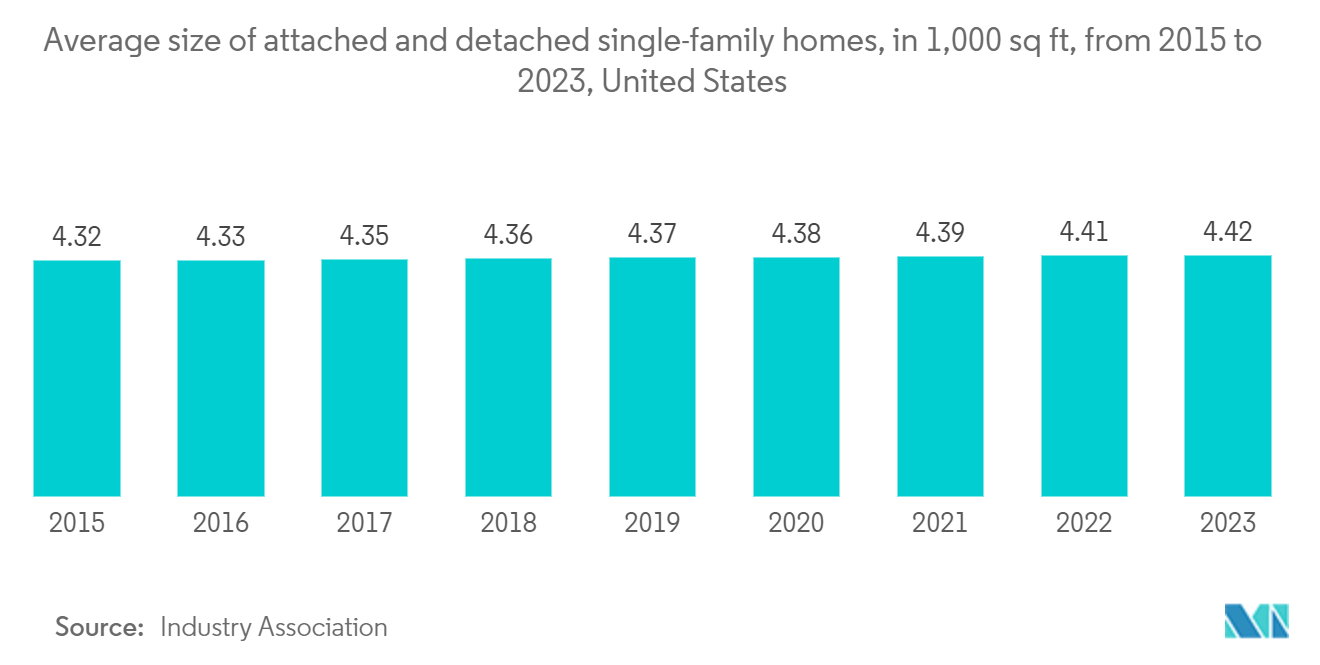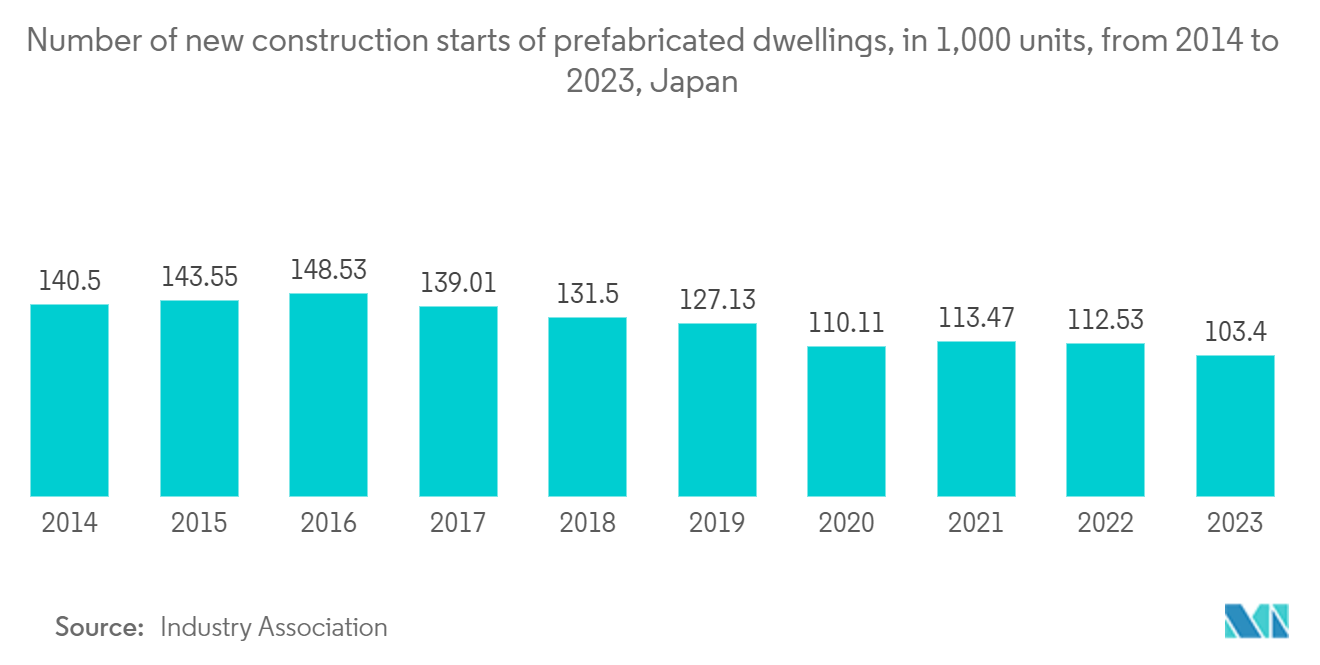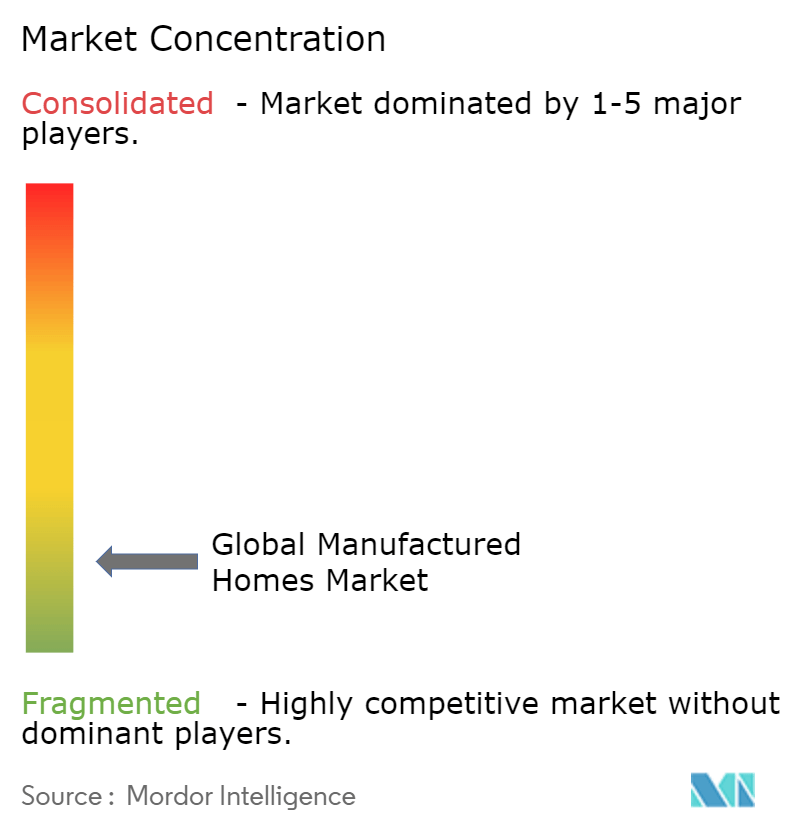Manufactured Homes Market Analysis
The Manufactured Homes Market size is estimated at USD 25.64 billion in 2025, and is expected to reach USD 33.26 billion by 2030, at a CAGR of 5.34% during the forecast period (2025-2030).
The manufactured housing industry is emerging as a solution to escalating housing costs and evolving consumer preferences. Bolstered by technological innovations, sustainability initiatives, and heightened investments from both public and private sectors, the industry is witnessing a surge in the construction and adoption of contemporary manufactured homes.
Affordability and efficiency are driving a notable uptick in demand for manufactured housing. Havenpark Communities, a leading player in the field, reported a 20% increase in applications for their manufactured homes in 2023 compared to the prior year. The company has invested approximately USD 55 million in infrastructure and community enhancements and is projected to invest an additional USD 30.1 million by the end of 2024. This includes the installation of nearly 1,300 new homes across multiple regions. Such initiatives underscore a growing interest in energy-efficient, modern homes, challenging outdated perceptions of prefabricated housing.
Despite economic challenges, the production of manufactured homes remains steady. In 2023, approximately 93,000 manufactured homes were produced, with significant activity in states such as Florida, Texas, and Colorado. The adoption of advanced construction methods and digital tools, such as virtual home tours, has expanded the accessibility and appeal of these homes, attracting diverse consumer segments, including first-time buyers and retirees.
Sustainability is becoming a cornerstone of the industry's transformation. Manufacturers are increasingly utilizing eco-friendly materials and integrating energy-efficient systems to cater to environmentally conscious buyers. The use of recycled construction materials, efficient HVAC systems, and waste-reduction strategies during production highlights the industry's commitment to sustainability.
However, the industry continues to face challenges such as rising construction costs, supply chain disruptions, and elevated borrowing rates. Developers are focusing on operational efficiencies and innovative solutions to address these issues and sustain the appeal of manufactured housing as an affordable and viable option for modern homebuyers.
Manufactured Homes Market Trends
Modernization of Single-Family Manufactured Homes in North America
In North America, the single-family manufactured housing segment is rapidly evolving, with homes now designed to rival the quality and aesthetics of traditional site-built houses. This modernization is driven by innovations from market leaders and regulatory advancements reshaping perceptions and boosting adoption.
For instance, Clayton Homes, a leading player in the U.S. manufactured housing market, has introduced energy-efficient “net-zero” homes featuring high-end finishes and customizable designs. These homes are equipped with modern features such as solar panels and advanced insulation, making them a competitive alternative to site-built homes. The U.S. Department of Housing and Urban Development (HUD) updated its building codes in September 2024 to support the adoption of such innovations, further solidifying manufactured housing as a viable choice for single-family homebuyers.
Additionally, Skyline Champion Corporation has expanded its portfolio of customizable manufactured homes, targeting middle-income buyers. In April 2024, the company announced the launch of a new line of single-family manufactured homes that emphasize sustainability and design flexibility, aligning with consumer demand for homes that combine affordability with aesthetic appeal.
Despite these advancements, zoning restrictions remain a challenge, particularly in suburban areas. However, certain regions are actively revising their policies to integrate manufactured homes into single-family neighborhoods. For instance, new policies in Texas and Florida in 2024 have enabled the development of modern manufactured housing communities, helping to alleviate housing shortages and improve affordability for first-time buyers.
Urbanization Driving the Demand for Affordable Modular Housing in Asia-Pacific
As urbanization surges across the Asia-Pacific, the demand for swift and affordable housing solutions intensifies. Modular housing emerges as a critical solution to these urban challenges. Unlike traditional methods, modular homes, being prefabricated and scalable, ensure faster construction and cost-efficiency.
As of late 2023, Japan relies significantly on modular housing to address its urban housing demands. From 2020 to 2023, prefabricated homes consistently accounted for approximately 15% of the nation's new residential constructions. Urban centers, such as Tokyo and Kanagawa, lead in adopting these homes, supported by innovative manufacturers like Sekisui House and Daiwa House, who are advancing modular designs tailored for urban apartments.
In India, programs like the “Pradhan Mantri Awas Yojana” (PMAY) are driving the adoption of modular housing. In January 2024, Tata Steel’s Nest-In division expanded its prefabricated housing solutions to metropolitan areas like Delhi and Mumbai, effectively addressing urban housing shortages. This expansion highlights the role of modular housing in supporting large-scale urban housing initiatives .
Australia is rapidly emerging as a key market for modular housing, driven by government investments in prefabrication technologies. In April 2024, the Australian Research Council allocated AUD 6 million (USD 3.83 million) to the Advanced Manufacturing of Prefabricated Housing program, achieving a 40% reduction in construction delays and a 50% decrease in carbon emissions. These developments position modular housing as a sustainable and cost-effective solution for urban areas.
With urbanization on the rise, the Asia-Pacific region increasingly views modular housing as a transformative solution, enabling faster, more efficient, and sustainable urban development.
Manufactured Homes Industry Overview
The manufactured homes market is fragmented in nature, considering the presence of several players, with the major players holding little market share. Cavco Industries, Clayton Homes, Skyline Champion Corporation, Karmod Prefabricated Technologies, and Adria are some of the major players in the market. The increasing popularity of manufactured home communities in North America and the increasing adoption of prefabricated construction across the globe make it easier for new players to enter the market. Still, these small players face fierce competition from established major players. Countries, where prefabricated construction has a certain stigma attached to it face high competition for the existing small demand in the respective market. The major players in the market mostly offer a wide range of products to have a competitive edge over other players. Start-ups try to break into the market with innovative products and technology integration.
Manufactured Homes Market Leaders
-
Clayton Homes
-
Skyline Champion Corporation
-
Karmod Prefabricated Technologies
-
Adria
-
Cavco industries
- *Disclaimer: Major Players sorted in no particular order
Manufactured Homes Market News
- December 2024: Oak Ranch Manufactured Homes Community in Austin, Texas, has expanded its portfolio to include over 180 energy-efficient homes. With prices starting at USD 105,000, Oak Ranch offers a cost-effective solution for homeownership in one of the fastest-growing cities in the United States. The energy-efficient features enable homeowners to achieve an average reduction of 38% in their annual utility expenses.
- October 2024: In the previous year, manufactured homes constituted 9.6% of new single-family home constructions in Pennsylvania. Currently, 21.2 million Americans reside in manufactured homes, which account for approximately 10% of all new home constructions in the United States annually.
Manufactured Homes Industry Segmentation
Manufactured homes are built as dwelling units of at least 320 square feet with a permanent chassis to assure the initial and continued transportability of the home. The requirement to have a wheeled chassis permanently attached differentiates manufactured housing from other types of prefabricated homes, such as modular homes. The manufactured homes market is segmented by type (single-family and multi-family) and by geography (North America [US, Canada, and Mexico], Europe [Germany, UK, France, Italy, Spain, and the rest of Europe], Asia-Pacific [India, China, Japan, and Rest of the Asia-Pacific], and the Rest of the World [Latin America, and the Middle East and Africa]). The report offers market size and forecast values (USD billion) for all the above segments.
| By Type | Single Family | ||
| Multi Family | |||
| By Geography | North America | US | |
| Canada | |||
| Mexico | |||
| Europe | Germany | ||
| UK | |||
| France | |||
| Italy | |||
| Spain | |||
| Rest of the Europe | |||
| Asia-Pacific | India | ||
| China | |||
| Japan | |||
| Rest of the Asia-Pacific | |||
| Rest of the World | Latin America | ||
| Middle East and Africa | |||
Manufactured Homes Market Research FAQs
How big is the Global Manufactured Homes Market?
The Global Manufactured Homes Market size is expected to reach USD 25.64 billion in 2025 and grow at a CAGR of 5.34% to reach USD 33.26 billion by 2030.
What is the current Global Manufactured Homes Market size?
In 2025, the Global Manufactured Homes Market size is expected to reach USD 25.64 billion.
Who are the key players in Global Manufactured Homes Market?
Clayton Homes, Skyline Champion Corporation, Karmod Prefabricated Technologies, Adria and Cavco industries are the major companies operating in the Global Manufactured Homes Market.
Which is the fastest growing region in Global Manufactured Homes Market?
North America is estimated to grow at the highest CAGR over the forecast period (2025-2030).
Which region has the biggest share in Global Manufactured Homes Market?
In 2025, the North America accounts for the largest market share in Global Manufactured Homes Market.
What years does this Global Manufactured Homes Market cover, and what was the market size in 2024?
In 2024, the Global Manufactured Homes Market size was estimated at USD 24.27 billion. The report covers the Global Manufactured Homes Market historical market size for years: 2020, 2021, 2022, 2023 and 2024. The report also forecasts the Global Manufactured Homes Market size for years: 2025, 2026, 2027, 2028, 2029 and 2030.
Our Best Selling Reports
Manufactured Housing Market Report
The global manufactured housing market is experiencing significant growth, driven by its affordability and efficiency. These homes, also known as prefabricated homes, are fully built in factories and then transported to various sites. This market encompasses both residential and non-residential sectors, including hotels, schools, and office spaces across North America, Europe, and Asia-Pacific. The industry forecast highlights the increasing demand for these modular homes, which offer extensive customization options from simple single-section units to elaborate multi-section setups.
Manufactured homes are gaining traction due to advancements in energy efficiency and sustainable construction practices, aligning with broader environmental sustainability goals. The market report provides a comprehensive market forecast and historical overview, underscoring the expanding influence of manufactured homes in the housing market. The industry outlook is positive, with significant savings in construction costs and time being a major driver.
Market data and industry statistics from Mordor Intelligence reports indicate a robust market growth trajectory. The market size and market share of manufactured homes are expanding, with key market trends pointing towards greater adoption in various regions. The market segmentation covers single-family and multi-family types, with detailed insights available in the report PDF.
The industry analysis reveals that the market leaders are capitalizing on the growing demand for prefabricated homes. The industry information and industry reports provide valuable insights into the market value and market overview. The market predictions and market review suggest a strong market outlook, with market leaders poised to benefit from this growth.
For a detailed understanding, the report example and report PDF offer an in-depth analysis of the market segmentation and market value. The industry research highlights the importance of sustainable practices and energy efficiency in driving market growth. The industry size and industry sales are set to increase, with market forecasts predicting continued expansion. The industry trends and market segmentation offer a comprehensive view of the market landscape, making this report essential for research companies and stakeholders in the manufactured housing industry.







